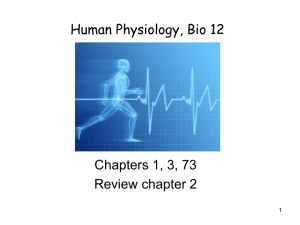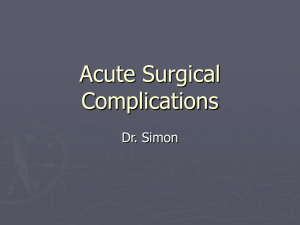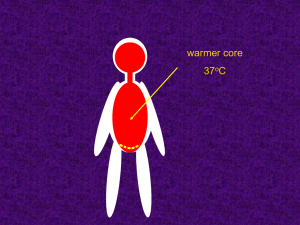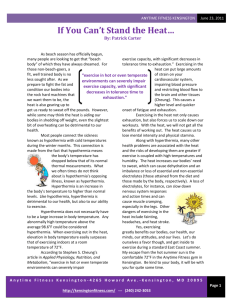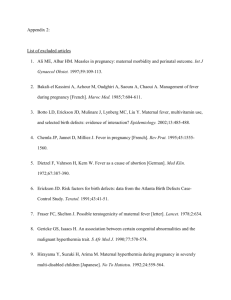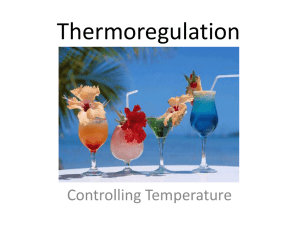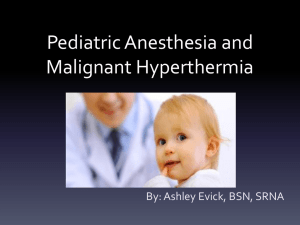Thermoregulation
advertisement
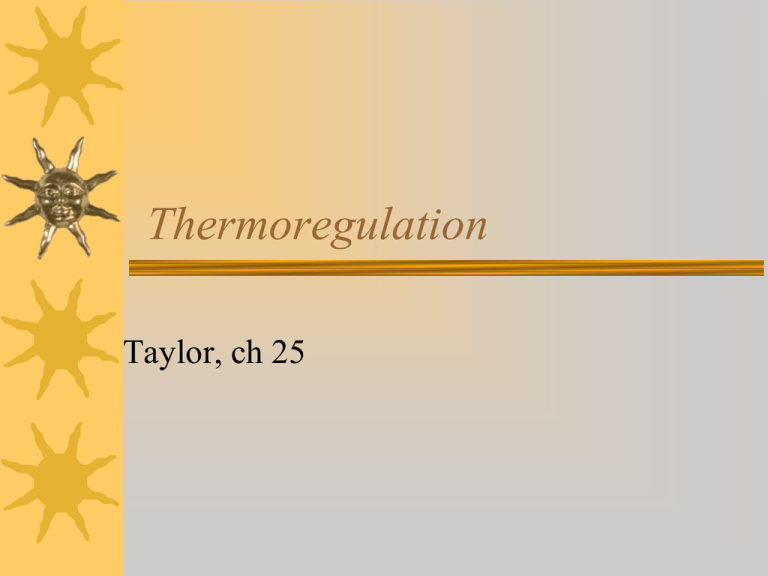
Thermoregulation Taylor, ch 25 Objectives Please refer to page 3 of your Course Description under “Domain of the Individual.” There you will find the outcomes listed for Thermoregulation. These outcomes are: – Explain the principles and mechanisms of thermoregulation. – Describe nursing measures that promote heat loss and heat conservation. – List S/S and identify interventions for hypo and hyperthermia. Objectives cont’d We will be discussing the concept of thermoregulation—in other words, what it means and how temperature is regulated in the body. We will also discuss hypo and hyperthermia and measures to control temperature. We will not discuss how to take a temperature. That is covered in the Vital Signs lecture. Thermoregulation How the body regulates heat loss and heat production. Heat loss has to equal heat production in order for the body temperature to stay constant. They occur simultaneously. Regulation is controlled by mechanisms in the body, the environment, and behaviors of the individual. Temperature Regulation Regulated by hypothalamus which has one part for heat loss, one for conservation. Hypothalamus receives info from thermoreceptors in the skin and body core Sends info to cerebral cortex (voluntary), sweat glands, blood vessels, and skeletal muscles (shivering) Heat Loss Controlled by anterior hypothalamus Can occur 4 ways: – – – – Radiation (loss from skin surface) Conduction (direct contact between objects) Convection (from air currents) Evaporation (perspiration) Which Is It? Dilation of blood vessels causes heat loss by which method? Jumping in a cool lake on a hot day can cause heat loss by which method? Standing in front of an air conditioner can cause heat loss by which method? Exercising can cause heat loss by which method? Heat Production Controlled by posterior hypothalamus Heat production can occur in three ways: – Increased metabolic rate from exercising, increased thyroid gland activity, or fever (10% for every degree) – Shivering (skeletal muscle contraction) – Nonshivering thermogenesis in newborns from metabolizing vascular brown tissue Factors Affecting Temperature Age Nutritional status Exercise Drugs, anesthesia Hormones Alcohol, cigarettes Circadian rhythm (Figure 32-2) Hot and cold liquids Stress Environment Illness/disease Temperature Terms Pyrexia, febrile (elevated temperature) Afebrile (absence of fever) Hyperthermia (heat exhaustion, heat stroke) Hypothermia (frostbite) Antipyretic (against fever) FUO (fever of unknown origin) Anatomy of a Fever Pyrogens cause body temp to rise Hypothalamus responds by raising the set point from 98.6 to a new level. Body responds by heat-producing actions like chills and shivering. When new set point is reached, temperature plateaus and body stops producing heat Temp starts dropping d/t immune system, antipyretics, and/or antibiotics Body responds by sweating, flushing to lose heat Fever Patterns Sustained—continuously elevated above normal with very little fluctuation Remittent—continuously elevated above normal with spikes Intermittent—fever spikes with returns to normal (<24h) Relapsing—fever spikes with returns to normal (>24h) Fever S/S Headache Hot, dry skin Flushed skin “Glassy” eyes Thirst Malaise Delirium Fever Can Be Good! Important body defense Enhances immune system Stimulates WBC production Suppresses bacterial growth Stimulates interferon which fights viruses However, very high (>102.2) or prolonged fevers can be dangerous d/t stress on body When Temperature Goes Awry Hypothermia—prolonged exposure to cold overwhelms body’s ability to produce heat. May be mild, moderate, or severe and can lead to frostbite (frozen cells) Hyperthermia—prolonged exposure to heat causes hypothalamus to lose ability to regulate temp. Can lead to heat exhaustion & heatstroke. Symptoms of Abnormal Temps Hypothermia – – – – – – – – – Temps <86 to 96.8 Falling VS Shivering Memory loss Depression Poor judgment Cyanosis Cardiac dysrhythmias Unconsciousness Hyperthermia – – – – – – – – – Temps up to 113 Low BP, high P Diaphoresis? Confusion Delirium Excess thirst Nausea Muscle cramps Unconsciousness Nursing Actions for Hyperthermia Maintain optimum fluid volume status (po or IV) 3 L/d Administer antipyretics and antibiotics if appropriate Cooling blanket or cool wet towels Irrigations of stomach or bowel Rest Light cover Oscillating fans Dry linens and clothing Control environmental temp Nursing Actions for Hypothermia Remove wet clothes Wrap in blankets; keep head and neck covered and warm Lie next to warm person under blankets Drink hot liquids if conscious Avoid alcohol and caffeine


